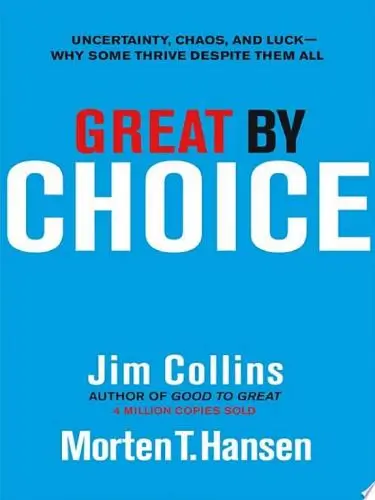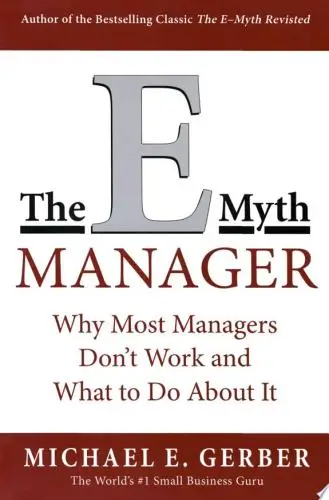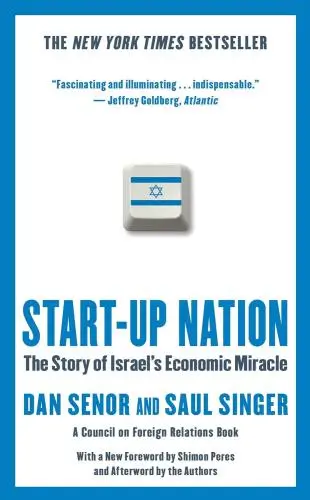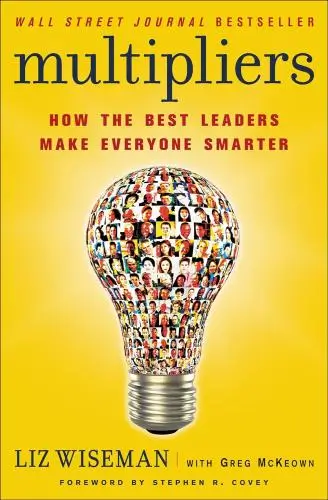Multipliers
How the Best Leaders Make Everyone Smarter
What's it about?
Multipliers is a compelling dive into leadership that transforms the way we think about unleashing the full potential of our teams. It contrasts Multipliers, leaders who amplify the intelligence of those around them, with Diminishers, those who drain it. Wiseman’s insights provide practical strategies for becoming a Multiplier to foster a culture of intelligence, creativity, and innovation. A must-read for anyone looking to elevate their leadership style and unlock the true capability of their team.
About the Author
Liz Wiseman, a leadership sage, illuminates the path to unlocking potential in her seminal work "Multipliers." With a keen insight into the power dynamics of the workplace, she crafts a persuasive narrative on how leaders can amplify their team's capabilities. Her writing is a beacon for those seeking to transform from mere managers to true cultivators of talent, showcasing her unique perspective on fostering collective intelligence.
10 Key Ideas of Multipliers
Leverage the Genius in Your Team by Identifying Unique Strengths
Every team member possesses unique strengths and areas of genius.
By identifying and leveraging these unique abilities, you can maximize productivity and innovation.
This approach encourages individuals to contribute their best, fosters a culture of ownership, and drives collective success.
Recognizing and utilizing the diverse talents within your team not only boosts morale but also leads to more creative and effective problem-solving.
Learn DeeperIdentify Unique Strengths: Start by having one-on-one conversations with each team member to understand their interests, past experiences, and areas where they feel most confident. Use this information to map out the unique strengths within your team.
Assign Roles Based on Strengths: Once you've identified each team member's strengths, assign roles and tasks that align with these strengths. This ensures that everyone is working in their zone of genius, leading to higher engagement and productivity.
Create a Strengths-Based Culture: Encourage open discussions about strengths and weaknesses within the team. Foster an environment where it's okay to ask for help in areas that are not one's strength, and where team members can volunteer their strengths to assist others.
Celebrate Unique Contributions: Regularly acknowledge and celebrate when team members use their unique strengths to contribute to the team's success. This can be through shout-outs in team meetings, written acknowledgments, or rewards for outstanding contributions.
Facilitate Strengths-Based Development: Offer opportunities for team members to further develop their strengths through training, workshops, or projects that challenge them in their areas of genius.
- Example
A project manager identifies that one team member excels at creative thinking and problem-solving, while another is highly organized and detail-oriented. The project manager assigns the first team member to lead brainstorming sessions for innovative solutions, while the second team member is tasked with project planning and execution details.
- Example
During a team meeting, a leader asks each member to share a recent instance where they felt they were working at their best and what they were doing. This exercise not only helps in identifying strengths but also allows team members to see how their unique abilities contribute to the team's goals.
Foster an Environment of Intellectual Curiosity Through Inquiry
Encourage team members to ask questions and explore new ideas without fear of criticism.
This creates an environment where intellectual curiosity thrives, leading to innovative solutions and continuous improvement.
By valuing questions over answers, you empower your team to challenge assumptions and think critically, which is essential for growth and adaptation in a rapidly changing world.
Learn DeeperCreate a 'No Bad Questions' Day: Once a week, dedicate time for your team to ask any questions they have, no matter how basic or complex. This not only encourages curiosity but also helps identify gaps in understanding or areas for improvement.
Implement a 'Learning Hour': Encourage your team to spend an hour each week learning something new related to their work. This could be through online courses, reading articles, or exploring new tools. Share insights or learnings in a common forum to foster a culture of continuous learning and curiosity.
Start Meetings with a Question: Instead of diving straight into the agenda, begin your meetings by asking an open-ended question related to the project or work at hand. This primes the team to think critically and creatively, setting a tone of inquiry and exploration.
Encourage Cross-Departmental Curiosity: Set up informal sessions where team members from different departments share interesting aspects of their work. This not only broadens everyone's understanding of the organization but also sparks new ideas and collaborations.
- Example
A software development team implements a weekly 'Tech Exploration' session where each member shares something new they've learned about coding practices, tools, or technologies. This fosters a culture of continuous learning and encourages team members to stay curious about advancements in their field.
- Example
A marketing team starts each strategy meeting with a 'What If?' question, such as 'What if we had an unlimited budget for our next campaign?' or 'What if we could partner with any brand in the world?'. This exercise stretches the team's creativity and encourages them to think outside the box, leading to more innovative campaign ideas.
Stretch Team Capabilities by Setting Ambitious Goals
Setting ambitious, yet achievable goals motivates your team to stretch their capabilities and reach beyond their comfort zones.
This tactic not only accelerates personal and professional growth but also drives team performance to new heights.
Ambitious goals act as a catalyst for innovation and resilience, pushing the team to overcome obstacles and achieve exceptional results.
Learn DeeperIdentify Stretch Goals: Start by understanding your team's current capabilities and then set goals that are just out of reach but not impossible. This could mean aiming to increase sales by a certain percentage, launching a new product faster than before, or achieving a higher customer satisfaction score.
Foster a Supportive Environment: Encourage a culture where mistakes are seen as learning opportunities. This will empower your team to take risks and innovate without the fear of failure. Regularly celebrate small wins to keep morale high.
Provide Necessary Resources and Training: Ensure your team has access to the tools, information, and training they need to pursue these ambitious goals. This might involve investing in new technology, bringing in external experts for workshops, or allocating time for research and development.
Regular Check-ins and Adjustments: Set up regular meetings to track progress towards the goals, discuss any challenges, and adjust strategies as necessary. This keeps the team aligned and allows for pivoting when certain approaches aren't working.
- Example
A software development team aims to reduce their app's load time by 50% within six months. They start by analyzing current performance bottlenecks, then prioritize tasks that will have the biggest impact. The team experiments with new technologies and optimizes code, celebrating each improvement along the way.
- Example
A customer service team sets a goal to improve their customer satisfaction score by 20% in one year. They implement a new feedback system to better understand customer needs, provide additional training for team members, and introduce a mentorship program to quickly onboard new employees. Progress is reviewed monthly, with adjustments made based on customer feedback and team input.
Cultivate a Culture of Debate to Enhance Decision-Making
Promote a culture where debate is encouraged as a means to refine ideas and enhance decision-making.
Constructive debate allows for diverse perspectives to be heard, fostering a deeper understanding of issues and leading to well-informed decisions.
This approach ensures that all angles are considered, minimizing biases and blind spots, and ultimately leading to better outcomes.
Learn DeeperEncourage Open Dialogue: Start by fostering an environment where team members feel safe and encouraged to express their opinions. This can be done by setting clear guidelines for respectful communication and actively soliciting input from all members, especially those who may be quieter or less inclined to speak up.
Implement Structured Debate Sessions: Schedule regular meetings specifically designed for debating key decisions or strategies. Clearly define the topic of debate, assign roles if necessary (e.g., proponent and opponent), and ensure that each side is given equal time to present their arguments. After the debate, discuss as a group to reach a consensus or make a decision.
Train in Effective Debate Techniques: Offer training sessions or workshops on effective debate and argumentation techniques. This can help team members learn how to constructively challenge ideas, present their arguments persuasively, and listen actively to others' perspectives.
Celebrate Diverse Perspectives: Make it a point to acknowledge and celebrate the diversity of thought within your team. Highlight instances where debate and differing opinions have led to successful outcomes, reinforcing the value of this approach.
- Example
A software development team is trying to decide between two programming languages for a new project. They organize a structured debate where half of the team argues for one language, citing its scalability and support community, while the other half advocates for the other, highlighting its ease of use and faster development time. After a lively discussion, they decide based on the points raised during the debate.
- Example
A marketing team is divided over the direction of a new campaign. The team leader sets up a debate, asking each side to prepare a short presentation on their proposed approach, including target demographics, expected outcomes, and potential risks. Following the debate, the team combines the best elements of both proposals into a cohesive plan.
Invest in Professional Development to Build Capability
Actively investing in the professional development of your team members not only enhances their skills but also demonstrates a commitment to their growth.
This investment can take many forms, from formal training programs to mentorship and coaching.
By prioritizing development, you build a more capable and adaptable team, ready to tackle current and future challenges.
Learn DeeperIdentify Individual Learning Styles and Needs: Start by understanding the unique learning preferences and professional aspirations of each team member. This personalized approach ensures that the development opportunities you provide are both relevant and engaging.
Create a Learning Plan Together: Collaborate with your team members to develop a tailored learning plan that aligns with their career goals and the organization's objectives. This plan could include a mix of online courses, workshops, conferences, and reading materials.
Encourage Mentorship and Peer Learning: Pair up team members for mentorship opportunities, encouraging those with more experience or expertise in certain areas to share their knowledge. This not only fosters a culture of learning but also strengthens team bonds.
Allocate Time for Learning: Encourage your team to dedicate a specific amount of time each week to focus on their professional development. This could be through attending webinars, reading industry-related articles, or working on a project that allows them to apply new skills.
Measure Progress and Celebrate Achievements: Regularly review the learning plan with each team member, assessing progress towards their goals. Celebrate achievements, no matter how small, to keep motivation high.
- Example
A marketing manager notices that one of her team members is interested in digital analytics but lacks the necessary skills. She enrolls the team member in an online course and sets up bi-weekly check-ins to discuss learnings and how they can be applied to current projects.
- Example
An IT team leader identifies a gap in cloud computing expertise within his team. He organizes a series of internal workshops led by a team member who is proficient in cloud technologies, fostering peer learning and strengthening the team's capabilities in this area.
Deeper knowledge. Personal growth. Unlocked.
Unlock this book's key ideas and 15M+ more. Learn with quick, impactful summaries.
Read Full SummarySign up and read for free!
Multipliers Summary: Common Questions
Experience Personalized Book Summaries, Today!
Discover a new way to gain knowledge, and save time.
Sign up for our 7-day trial now.
No Credit Card Needed

Similar Books

Emotional Intelligence at Work
Dalip Singh
Seeing the Big Picture
Kevin Cope
Leadership Is Concept Heavy
Dr. Enoch Antwi
Great by Choice
Jim Collins
The Leader′s Guide to Coaching in Schools
John Campbell
Preparing School Leaders for the 21st Century
Stephan Gerhard Huber
The E-Myth Manager
Michael E. Gerber
Leadership Is Language
L. David Marquet
Start-up Nation
Dan Senor
The Founder's Dilemmas
Noam WassermanTrending Summaries

Peak
Anders Ericsson
Never Split the Difference
Chris Voss
Smart Brevity
Jim VandeHei
The Psychology of Money
Morgan Housel
The First 90 Days
Michael D. Watkins
Atomic Habits
James Clear
Thinking, Fast and Slow
Daniel Kahneman
The Body Keeps the Score
Bessel van der Kolk M.D.
The Power of Regret
Daniel H. Pink
The Compound Effect
Darren HardyNew Books

Job Interviews For Dummies®
Joyce Lain Kennedy
Job Interviews In A Week
Alison Straw
Handbook of Career Development
Gideon Arulmani
The Art of Spending Money
Morgan Housel
$100M Offers
Alex Hormozi
A Candle for Kiri
Edna Mae Holm
Principles of Marketing, Global Edition
Gary Armstrong
Serpent Rising: The Kundalini Compendium
Neven Paar
Feeling Is the Secret
Neville Goddard

